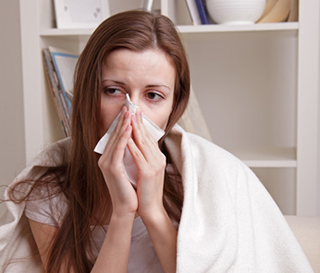What is FLU DRIFT?
and how does it affect our seasonal flu vaccine?

About the flu
Influenza is a contagious respiratory illness caused by influenza A and influenza B viruses. Every year, several strains of seasonal flu circulate, causing hospitalizations in an estimated 12,000 Canadians, and 3,500 deaths.1
Understanding immune protection
You develop immunity to a virus when you are exposed to it. That exposure can occur in one of two ways – when you catch a particular strain of flu, or when you are vaccinated against that strain. Exposure triggers your body to develop antibodies that recognize and fight that particular strain of virus.2
What is flu drift?
Flu drift – known scientifically as viral drift – refers to a gradual process of small genetic changes that occur in a virus over time as it reproduces. Usually, the virus that evolves is still sufficiently similar to its former self that the immune system continues to recognize it and defend against it – this is called cross-protection.
When the virus evolves to a greater extent, it may become unrecognizable to the immune system and the antibodies you have developed do not defend against it. This is why the flu strains used in the seasonal vaccines are reviewed each year, and a new formulation developed to keep up with evolving viruses.3
Vaccine development based on emerging new flu strains
It’s a world-wide effort! For over half a century, the World Health Organization’s Global Influenza Surveillance and Response System (GISRS) has monitored viruses that cause flu in human populations. This network of 142 national influenza centres in 113 different countries works in real time to identify strains of the flu virus that are making people ill, how quickly those strains are spreading, and how effective previous vaccines have been against them.4,5
Based on that information, scientists of the six WHO Collaborating Centers, including the U.S. Centers for Disease Control and Prevention, or the “CDC”, develop a new vaccine that targets flu strains predicted to cause illness during the upcoming flu season. Once the vaccine has been thoroughly tested and approved by the FDA, it is made available to the public. To read more about vaccine development5 visit https://www.scientificamerican.com/article/how-are-seasonal-flu-vaccines-made/.
The ability of a flu vaccine to protect a person against the flu depends primarily on how closely the viruses targeted by each new year’s vaccine match with those circulating and causing illness in that season.
When a vaccine mismatch occurs, the vaccine may provide less protection against the newer mismatched strains of flu; however, it will still protect against the other flu strains in circulation.6
When and why your family should get the flu vaccination
Everyone 6 months and older, including pregnant women and people with medical conditions should receive a flu vaccination.1 While the benefits of avoiding the flu vary for each family member, the whole family and the community you live in all benefit from herd immunity.6
Remember, the flu vaccination takes 2 weeks to take effect, so give your system time to develop those protective antibodies before flu season begins. Ideally, you should be vaccinated before the end of October, when the viruses begin circulating in your community. But getting your flu shot any time during flu season – which peaks between December and February and can last into May – is better than having no protection at all.6
Get up-to-date information about current flu strains in Canada at https://www.canada.ca/en/public-health/services/diseases/flu-influenza/influenza-surveillance/weekly-influenza-reports.html.
Talk to your doctor today about what immunizations you may need, and visit Vaccines411.ca to find the vaccinating flu clinic nearest you.
Brought to you by Vaccines411.ca – know where to go for your vaccinations.
This information should not be used as a substitute for the medical care and advice of your doctor. There may be variations in treatment that your physician may recommend based on individual facts and circumstances.
Read more Vaccines411® Articles 
Sources
Note: the hyperlinks that direct to other sites are not continuously updated. It is possible that some links become untraceable over time. Thank you.
- For health professionals: Flu (influenza) - Canada.ca.
https://www.canada.ca/en/public-health/services/diseases/flu-influenza/health-professionals-flu-influenza.html - Understanding How Vaccines Work. February 2013. CDC.
https://www.cdc.gov/vaccines/hcp/conversations/downloads/vacsafe-understand-color-office.pdf - How the Flu Virus Can Change: “Drift” and “Shift” | Seasonal Influenza (Flu) | CDC
https://www.cdc.gov/flu/about/viruses/change.htm - Global Influenza Surveillance and Response System (GISRS). 2018.
http://www.who.int/influenza/gisrs_laboratory/en/ - Sabrina Stierwalt. Everyday Einstein. February 4, 2016. How Are Seasonal Flu Vaccines Made?
https://www.scientificamerican.com/article/how-are-seasonal-flu-vaccines-made/ - Misconceptions about Seasonal Flu and Flu Vaccines | Seasonal Influenza (Flu) | CDC
https://www.cdc.gov/flu/prevent/misconceptions.htm



